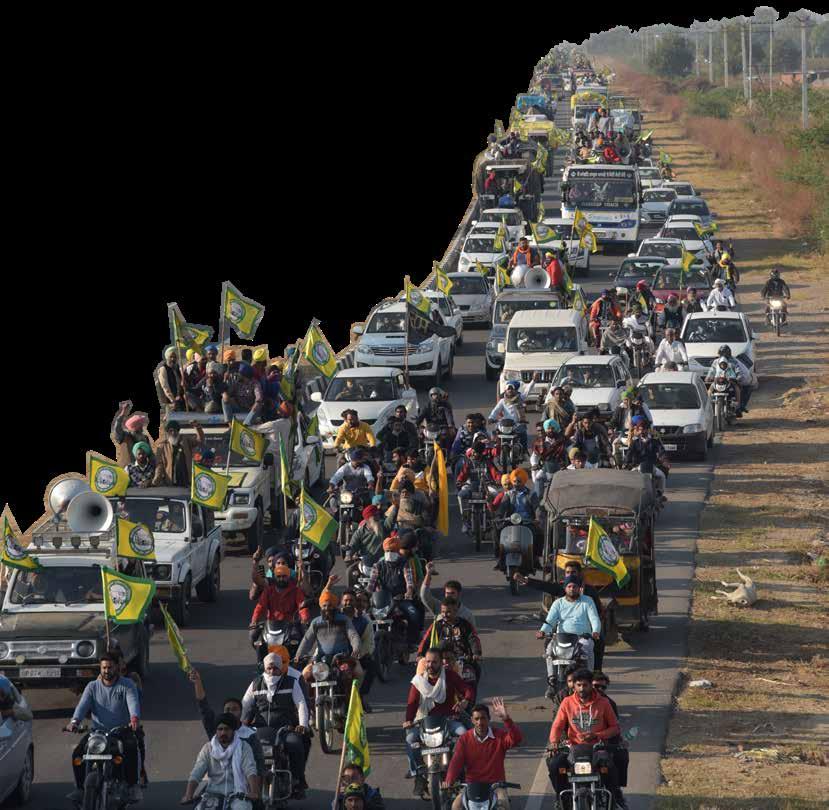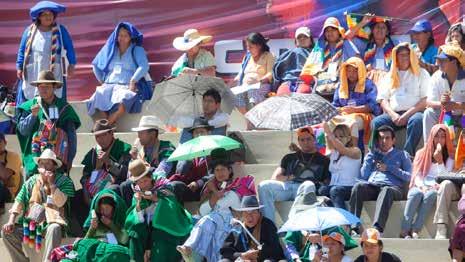
5 minute read
Anvee Bhutani Farmers Protest in India: explained
ndia: explained i Farmers protest in
Anvee Bhutani, Human Sciences at Magdalen College
Advertisement
Last month, Rihanna and Greta Thunberg’s tweets single-handedly attracted a global audience to the farmers’ protest, which was previously confined to India. Dubbed “the largest protest in human history”, it is estimated that over 250 million Indians worldwide along with their supporters have taken to the streets in hopes of asserting solidarity with the farmers and posturing themselves against the governmental change. But with an issue so vast and multifaceted as the farmers protests, it is important to understand both why and how the situation has reached the current climate.
The past few months have seen farmers, predominantly from the northern Indian states of Punjab, Haryana and Rajasthan, take action against changes to agricultural laws. Initially, farmers from these areas unionised and began to march towards the capital city of Delhi under the slogan “Delhi Challo” ("Let’s Go to Delhi"). It is estimated that over time upwards of 300,000 people have converged at the various entry points into Delhi where they have been met by water cannons and tear gas from police and law enforcement. However, this protest made history when, in late November, over 250 million people across the subcontinent participated in a general strike in solidarity with the protesting farmers. The global support and solidarity the movement has also received from South Asian diaspora groups has made this the largest protest in human history.
Protests were triggered by changes to farming legislation, which were signed into law on the 28th of September, 2020. The disputed laws are: the Farmers’ Produce Trade and Commerce Act, the Farmers Agreement on Price Assurance and Farm Services Act and the Essential Commodities Act.
The Farmers’ Produce Trade and Commerce Act aims to completely open the sale of produce outside the Agricultural Produce Market Committees, also known as the ‘mandis’, which creates a possibility for more competition and better pricing for farmers. Rather than the government acting as a mediator. under the act, businesses are left completely free to negotiate with farmers themselves. This leaves massive room for exploitation and could also result in the ‘mandi’ system being permanently phased out.
The Farmers Agreement on Price Assurance and Farm Services Act creates a framework for contract farming which allows for the sale of farming produce at a mutually pre-agreed price to massive retailers. This shifts the negotiating power in the agricultural sphere away from farmers and towards big businesses, leaving them at their mercy.
The Essential Commodities Act takes away cereals, pulses, oilseeds, edible oils, onion and potatoes from the list of essential commodities. Therefore, the stocking of these commodities is no
Who is protesting?
What are the new laws?
longer regulated except in severe scenarios where the government sees fit, such as war and famine. This means that companies can stockpile and drive up the price of such commodities whilst paying extremely low prices to farmers.
Together, these laws decrease government involvement and regulation of the agricultural sector, resigning it to the free market economic system. Both production through contract farming and sale through complete deregulation open the market and consequently the farmers to vulnerability.
The passing of these laws in the context of India’s political climate makes it all the more significant. For decades, the Indian government has offered guaranteed prices to farmers for certain crops, providing long-term certainty that allows them to make investments for the next crop cycle. However, the new bills have no mention of this.
Although Indian Prime Minister Narendra Modi claims that these new laws will give farmers more autonomy to set their own prices and sell directly to private businesses, farmers argue that these laws could help big companies drive down prices. It could become easier for corporations and tycoons, like business magnate and owner of Reliance Industries, Mukesh Ambani, to exploit agricultural workers. Though farmers could sell crops at elevated prices if the demand is there, they could struggle to meet the minimum price in years when the supply in the market is too great.
Why is this a political issue?
March to Delhi, 27 November 2020
As a largely agricultural country, farmers in India have been struggling for years due to low crop prices, rising costs, demonetisation and widespread droughts - even despite the government subsidies and tax exemptions. Farmer debt has led to an increase in farmer suicides in recent years, especially in India’s so-called “bread basket” regions like Punjab and Haryana which are responsible for most of the country’s agricultural produce. It is also important to note that the bills were passed without the standard parliamentary procedure or debate.
In Oxford, students gathered in December to oppose these new farm bills in protests that were collectively organised by the Oxford India Society and Oxford South Asian Society. A group of over 60 students stood against the right-wing and anti-farmer Bharatiya Janata Party (BJP) government; an event that was covered not only by the student press but also international media. Students have put on panel events, signed open letters and passed an SU motion to voice their support for the farmers. Yet they remain fundamentally limited by the extent that their lobbying can bring about any governmental change.
After months, negotiations between the BJP government and representatives of the protesting farmers are looking like they are at a stalemate. Despite some international solidarity, official reports of the initial phone call between US President Joe Biden and Indian Prime Minister Narendra Modi reported no mention of the farmers' protests. The UK government is also yet to engage in any kind of meaningful dialogue involving the ongoing issues between the farmers and the Indian state.
What has happened in Oxford?
Where do things go from here?
Nonetheless, neither the government nor the farmers intend to back down. There have been over 11 rounds of talks between leading farmers and the government, but a fierce deadlock appears to have set in. Some leading voices on behalf of the farmers have also indicated that they will not engage with the government until all farmers arrested on the 26th of January are released. Furthermore, concerning clampdowns by the Modi government on Indian democracy have been reported over the course of the protests, including the arrest of journalists and efforts to cut access to the internet. This suppression of dissent means that finding a solution remains difficult, but the world awaits a response.










